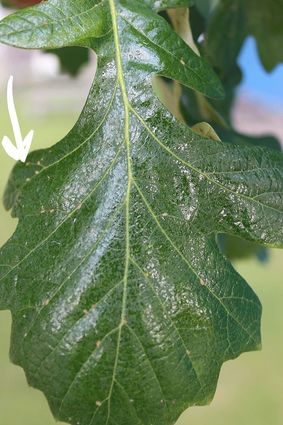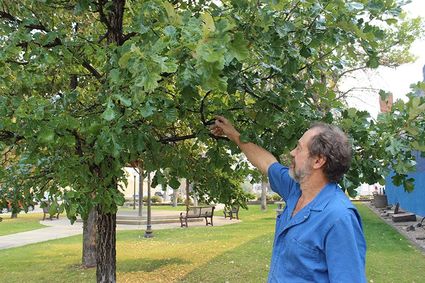Wondering about the sticky beginning to fall season? ...it's aphids!
September 20, 2017

In this closeup photo of an oak leaf, the arrow points to a group of aphids feeding on the leaf. Aphids feed on plant sap, which passes through them and forms the sticky 'honeydew' found so prominently this time of year. MSU Diagnosticians believe the uptick in sticky trees and bushes is a result of increased stress to the plants during the hot, dry summer.
Reporter's note: A couple of weeks ago Lynn Friede called and asked if I could come by the NAPA store in Chinook, husband Dan had something to show me. Dan took me to Centennial Park, the little park on the north side of NAPA, to an oak tree with a trunk about 10 inches, or so, in circumference. The tree was just around the corner from the front door of the store.
Pointing to some low hanging branches Dan said, "The other day I heard a terrible noise from the park and came out to see what was going on. There was a beautiful blue bird with its wings spread and caught on the leaves of the tree. The leaves were covered with a glue-like, clear substance." By the time he went back to the store to get something to help remove the bird, it had pulled one wing free and stripped off the feathers. Dan worked the other wing loose, causing a loss of more feathers. By the time the bird was loose it couldn't fly.
Dan used a soapy solution in water and sprayed the tree. To the touch the leaves were no longer sticky, but there were sticky patches and the leaves above reach still had a 'shiny' appearance. Dan said, "People need information about why the trees are so sticky this year and the problems it can cause for birds. They need to know how to deal with the problem." Here's what I learned about "sticky leaves" and the culprits that cause the mess.
Why the sticky sidewalks and streets?
I walk a lot and noticed this year, particularly under certain cottonwoods, big patches of sticky, dark material that felt 'tacky' as I walked through it. I recalled feeling sap on my vehicles when we lived in an area with lots of cottonwoods, but never to the extent I was experiencing this year.
With my limited knowledge of the natural world, this question was above my pay grade. I went to see the experts on plants, the folks at the MSU Extension Service in the courthouse annex. Brenda Jones, the Office Administrator, greeted me. After hearing my question about sticky leaves, she said, "It's funny you would bring that up. Just this week I had a similar question." Brenda added, "We have access to some plant experts at Bozeman, I'll see what I can find out."
I told Brenda about the tree in the park and where it was located. She took samples of leaves off the tree, as well as several others around town, and sent them to MSU for analysis. In the meantime, I did some research on my own, looking at internet sites about trees and talking to someone I knew who has knowledge both of trees and birds. I called Lois Butcher, a long time gardener and bird watcher.
Lois had not seen any birds hung up, like Dan Friede discovered, but said, "The problem seems to be worse this year. I think it's the dry and hot weather that is stressing the trees and this makes them more susceptible to aphids." Aphids? That was a bit of a shocker, those are those microscopic things I hadn't thought about since fourth grade science.
Aphids feed on plant sap
I learned by reading information from several websites there are many types and sizes of aphids and that, basically, they feed on the sap of plants. A waste product of their feeding (yes, we're talking about 'aphid poop') is honeydew-a sticky, sugar rich liquid. The sticky stuff is collected by certain other insects that use it to make a type of dark honey they feed on.
Interestingly, honeydew has long been observed by humans and even incorporated into religious and mythical stories. In Greek mythology, Zeus ( the supreme god of the Olympians) was fed the honeydew as an infant that dropped from ash trees. Some scholars believe the manna God provided to the wandering Israelites (book of Exodus) was sweetened with some form of honeydew.
Plant experts say aphids occur on most all trees and shrubs and usually cause no damage to the host plants. The insects are so small they are often not noticeable-some are less than one eighth of an inch in size. When they penetrate the plant with their mouth "the high-pressure liquid is forced out the anus of the aphid." Excessive amounts of aphids can remove enough sap to affect growth and vigor of a plant. What we are seeing, more than in normal years, is the sticky by product that has gone through the aphids.
Why more sticky leaves this year? The MSU scientists, in their examination of the sample leaves sent from Blaine County, noted about aphids, "They respond to stressed trees. Aphid damage can result in leaf curling, excessive honeydew secretion (cause of some of the stickiness), yellowing, stunted growth, and a general unhealthy look." Check, check and check...we've seen all those signs this hot and dry summer. It appears the trees and bushes are as stressed as us humans over the weather.
What to do?
The MSU report offers several approaches to control aphids on shrubs and trees. The report suggests, "Give the tree a lot of supplemental water until the ground freezes (this is beyond sprinkler irrigation)." Aphids don't like moisture so strong jets of water directed at the plants will help reduce the aphids. There are also soap-like products that can be mixed with water and sprayed on trees to control the aphids. Check the products to assure they will not affect the beneficial insects on plants.

Dan Friede points to an area in a small oak tree where he found a bird with its wings totally stuck to leaves. The bird got free but lost so many feathers it couldn't fly. MSU Diagnosticians found aphids in the leaves and explained the hot, dry weather has provided ideal weather for growing aphids. Aphids excrete 'honeydew,' the sugary, sticky substance found on many trees and on the ground, sidewalks and streets under cottonwood trees.
For bigger trees that are impractical to adequately spray there are systemic insecticides-chemicals soluble in water and absorbed by a plant. These treatments are typically mixed with water, then poured around the base of a shrub or tree. One treatment during the growing season is typically adequate.
Here are a few other techniques recommended by MSU Diagnosticians: prune out and discard dead branches; rake up and destroy affected leaves; adjust lawn sprinklers so they don't hit the canopy (excessive moisture can cause other plant problems like mold or fungal growth) and apply adequate, even extra, water around plants during very hot and/or dry conditions. Most hardware or garden centers can advise about topical controls or systemic treatments that can be poured around the plants.
In summary, the sticky we're seeing is caused by some little buggers we can hardly see. They are simply taking advantage of a hot, dry summer and working overtime on trees and bushes already stressed. There are some fairly easy fixes to the problem, and hopefully it's a one summer problem we won't see for a while. The "Journal" thanks Dan Friede for pointing out the problem, Brenda Jones for getting the samples to MSU and to the Diagnosticians at the university who identified the problem and offered some fixes.







